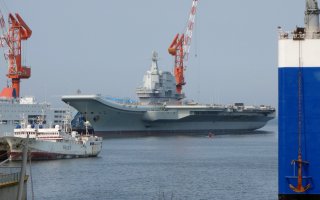How America Can Sink China's Aircraft Carriers in a War
Anti-ship weaponry is multiplying in numbers, range, and lethality as the Navy reawakens from its post-Cold War holiday from history.
No. It’s far more likely any fleet action will take place within reach of PLA anti-access weaponry. The waters shoreward of the island chains are the waters Beijing cares about most. They’re also waters where the United States, the keeper of freedom of the sea and guarantor of Asian allies’ security, is steadfast about remaining the predominant sea power. Conflict is possible in offshore seas and skies should Beijing and Washington deadlock over some quarrel.
And waging it could prove troublesome in the extreme. Talk about distributed lethality! As U.S. forces close in on the Asian mainland, they must traverse an increasingly dense thicket of A2/AD defenses. Carrier-killer ASBMs could cut loose throughout the Western Pacific on day one of a naval war, peppering vessels already in the theater or lumbering westward from U.S. bases. Offshore sentinels—principally missile-armed small craft and diesel attack subs—could disgorge barrages of antiship cruise missiles.
As if that offshore picket line isn’t enough, there’s shore-based antiship weaponry, including not just ASBMs but cruise-missile batteries and missile-armed warplanes stationed along the Chinese seaboard. A nuclear-propelled carrier is a big ship but a small airfield—and it would face off against a host of land-based airfields and missile platforms. All in all, A2/AD poses a wicked tactical and operational problem for U.S. skippers.
The oceangoing PLA Navy fleet could fare far better in a Western Pacific trial of arms than in the open Pacific, the Indian Ocean, or some other faraway expanse. In short, the PLA Navy is a modern-day fortress fleet. Such a fleet shelters safely within range of shore-based defenses—supplementing its own firepower to make the difference in action against a stronger antagonist.
Fortress fleets often meet a grim fate in combat on the open sea, denuded of that protective umbrella. Closer to home—within reach of shore fire support—they can acquit themselves well. China is counting on it.
A quick history lesson in parting. The fortress-fleet concept had humble origins. Sea-power pundit Alfred Thayer Mahan coined it—I think—to describe Russian Navy commanders’ habit of staying within reach of a fort’s gunnery to fend off superior opponents. The fleet was ostensibly the fort’s forward defender against naval assault, but an outgunned fleet could use the fort’s artillery as a protective screen.
Mahan had the guns of Port Arthur, the maritime gateway to the Bohai Sea and thence to China’s capital city, in mind when writing about fortress fleets. The Russian squadron based at Port Arthur stayed mainly under the guns while confronting Admiral Heihachiro Tōgō’s Imperial Japanese Navy (IJN) Combined Fleet during the Russo-Japanese War of 1904-1905.
The Port Arthur squadron was more or less safe so long as it remained within range of Port Arthur’s guns, but it accomplished little. Tōgō & Co. made short work of the fleet when Russian commanders offered battle on the high seas in August 1904. The debacle repeated itself in May 1905, when the Combined Fleet and the Russian Baltic Fleet met in action at Tsushima Strait.
Russian fleets, then, were simply outclassed by their IJN antagonists on a mano-a-mano basis. But imagine what may have transpired had the gunners at Port Arthur been able to rain accurate fire on Japanese ships not just a few but scores or hundreds of miles distant. That would have extended Mahan’s fortress-fleet logic throughout the combat theater. With long-distance backup from the fort, Russian seafarers may have emerged the victors rather than suffering successive cataclysmic defeats. The weak would have won.
That’s a rough analogy to today. Fortress China is festooned with airfields and mobile antiship weaponry able to strike hundreds of miles out to sea. Yes, the U.S. Navy remains stronger than the PLA Navy in open-sea battle. A fleet-on-fleet engagement isolated from shore-based reinforcements would probably go America’s way. But that hypothetical result may not make much difference since the two navies are more likely to join battle in confined Asian waters than on the open ocean.
The U.S. Navy, it seems, is optimized for the blue-water conflagration that’s least likely to occur. Question marks surround who would prevail in the scenarios that are most menacing and most likely to occur. Carrier-killing munitions may make the fortress fleet a going concern at last, long after the age of Mahan. And that suits Beijing fine.
James Holmes is Professor of Strategy at the Naval War College and coauthor of Red Star over the Pacific. The views voiced here are his alone.
This article first appeared in 2017.
Image: Wikimedia Commons

